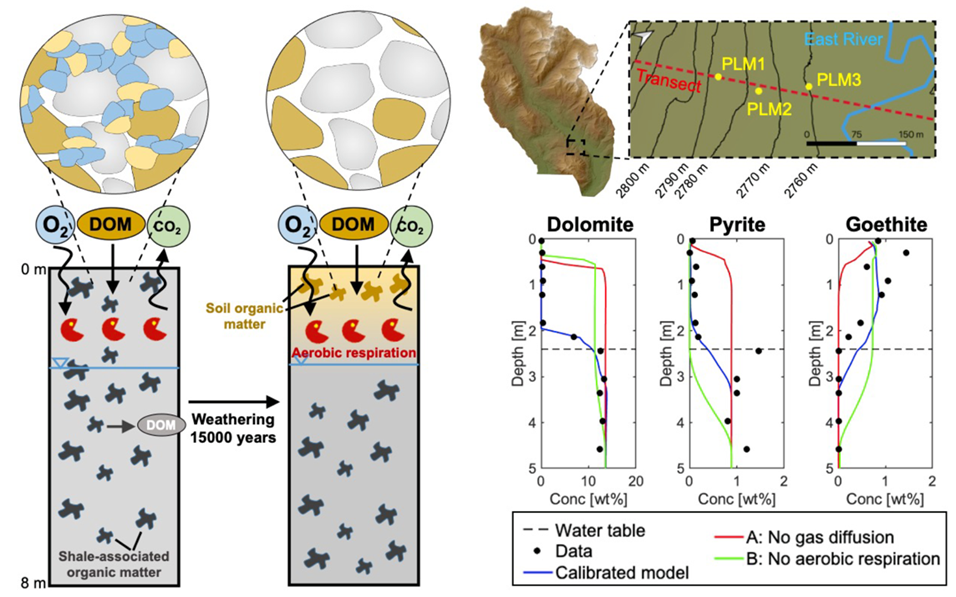November 09, 2022
Microbes Break Down Rocks
Soil biological activity controls the weathering of shale and the delivery of solutes in the subsurface.

Multiphase exchange at atmosphere/subsurface interface and microbial respiration drives long-term weathering of shale (left). Study hillslope in mountainous watershed (top right); stratified weathering fronts measured in field and simulated outcomes from reactive transport model (bottom right).
[Reprinted under a Creative Commons Attribution-NonCommercial-NoDerivatives 4.0 International License (CC BY-NC-ND 4.0) from Stolze, L., et al. "Aerobic Respiration Controls on Shale Weathering." Geochimica et Cosmochimica Acta 340 (1), 172-188 (2023). DOI:10.1016/j.gca.2022.11.002.]
The Science
The weathering or breakdown of sedimentary rock is an important component of global carbon, nutrient, and geochemical cycling. Scientists developed a new modeling approach to explore the long-term weathering of shale–a major sedimentary rock that makes up 25% of Earth’s continental rocks. They validated the model using observations from the East River watershed in Colorado and found that aerobic respiration–the consumption of oxygen and organic matter by microbes to make energy–exerts a key control on shale weathering. They showed that aerobic respiration strongly enhances removal of carbonate minerals through production of carbon dioxide and acidification of pore water. Furthermore, oxygen consumption by microbes limits the oxidation of sulfide minerals at depth.
The Impact
Shale, a widespread sedimentary rock, represents a large reservoir of carbon due to its high content of fossil organic matter and carbonate minerals. To better estimate global carbon budgets, scientists developed a modeling approach that accounts for the interplay between microbial respiration and mineral reactions. Furthermore, mineral reactions in the subsurface strongly influence the quality of headwaters. The model can be used to explore the impact of global warming on water delivered by mountains by simulating the chemical composition of streams in future climatic scenarios.
Summary
The interface between the Earth’s surface and the atmosphere typically involves complex interactions between hydrological, biogeochemical, and physical processes. Due to this complexity, understanding the mechanisms of shale weathering remains challenging. Scientists implemented a simulator that describes the long-term chemical weathering of Mancos shale (starting from the last glaciation period 15,000 years ago) at the East River study site in Colorado. The model accounts for gas exchange between the atmosphere and subsurface, percolation of water from precipitation, mass transfer between the gas and aqueous (solutes in water) phases under partially saturated conditions, and decomposition of soil and shale organic matter, water-rock interactions. The model was validated on mineral concentration profiles, solid organic carbon content, and carbon dioxide gaseous emissions measured in three monitoring wells. The researchers demonstrate that aerobic respiration of organic matter from plant litter is a key control for the development of the saprolite horizon in shale. This microbially mediated process limits oxygen, which largely prevents the dissolution of pyrite. In contrast, it releases carbon dioxide that drives the removal of carbonate minerals through the acidification of pore water.
Principal Investigator
Lucien Stolze
Lawrence Berkeley National Laboratory
[email protected]
Co-Principal Investigator
Eoin Brodie
Lawrence Berkeley National Laboratory
[email protected]
Funding
This work was supported by the Watershed Function Science Focus Area project at Lawrence Berkeley National Laboratory and funded by the Biological and Environmental Research (BER) Program within the U.S. Department of Energy’s (DOE) Office of Science.
References
Stolze, L., et al. "Aerobic Respiration Controls on Shale Weathering." Geochimica et Cosmochimica Acta 340 (1), 172–88 (2023). https://doi.org/10.1016/j.gca.2022.11.002.

